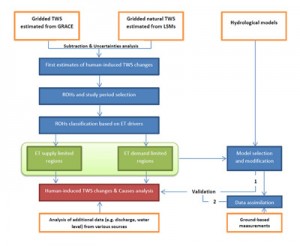Estimation of Human-Induced Changes in Terrestrial Water Storage through Integration of GRACE Satellite Detection and Hydrological Modeling: A Case Study of the Yangtze River Basin
Submitter: Z. Su, University of Twente, Faculty of Geo-Information Science and Earth Observation (ITC)
Area of Research: Hydrological modeling
Journal Reference:
Huang, Y., M.S. Salama, M.S. Krol, Z. Su, A.Y. Hoekstra, Y. Zeng, and Y. Zhou (2015). Estimation of human induced changes in terrestrial water storage through integration of GRACE satellite detection and hydrological modeling: A case study of the Yangtze River basin. Water Resour. Res., 51, 8494–8516, doi:10.1002/2015WR016923.
GEWEX Panel: Human Dimensions Cross-Cut, GEWEX Hydroclimatology Panel (GHP)
Impact:
A framework was proposed to investigate the human effects on terrestrial water storage (TWS). This framework integrates satellite observation with hydrological modeling, and considers the feedback between human water use and climate variation.
Summary:
Quantifying the human effects on water resources plays an important role in river basin management. In this study, we proposed a framework, which integrates the Gravity Recovery and Climate Experiment (GRACE) satellite estimation with macroscale hydrological model simulation, for detection and attribution of spatial terrestrial water storage (TWS) changes. In particular, it provides valuable insights for regions where ground-based measurements are inaccessible. Moreover, this framework takes into account the feedback between land and atmosphere and innovatively put forward several suggestions (e.g., study period selection, hydrological model selection based on soil moisture-climate interactions) to minimize the uncertainties brought by the interaction of human water use with terrestrial water fluxes. We demonstrate the use of the proposed framework in the Yangtze River basin of China. Our results show that, during the period 2003–2010, the TWS was continually increasing in the middle and south eastern reaches of the basin, at a mean rate of about 3 cm yr^-1. This increment in TWS was attributed to anthropogenic modification of the hydrological cycle, rather than natural climate variability. The dominant contributor to the TWS excess was found to be intensive surface water irrigation, which recharged the water table in the middle and southeastern parts of the basin. Water impoundment in the Three Gorges Reservoir (TGR) is found to account for nearly 20% of the human-induced TWS increment in the region where the TGR is located. The proposed framework gives water managers/researchers a useful tool to investigate the spatial human effects on TWS changes.
Link to the Article:
https://gewex.org/gewex-content/uploads/2016/11/RH_Human_changes_in_TWS.pdf


